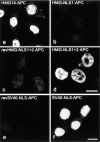Chromosomal proteins HMG-14 and HMG-17 are released from mitotic chromosomes and imported into the nucleus by active transport
- PMID: 9852141
- PMCID: PMC2132996
- DOI: 10.1083/jcb.143.6.1427
Chromosomal proteins HMG-14 and HMG-17 are released from mitotic chromosomes and imported into the nucleus by active transport
Abstract
The high mobility group 14/17 (HMG-14/-17) proteins form specific complexes with nucleosome core particles and produce distinct footprints on nucleosomal DNA. Therefore, they could be an integral part of the chromatin fiber. Here we show that during the cell cycle these proteins are transiently dissociated from chromatin. They colocalize with the nuclear DNA in interphase and prophase but not in metaphase and anaphase. They relocate into the nucleus and colocalize again with the DNA in late telophase, concomitantly with the appearance of the nuclear envelope. Thus, these nucleosomal binding proteins are not always associated with chromatin. Using reconstituted nuclei and permeabilized cells, we demonstrate that these two small proteins, with a molecular mass <10 kD, are actively imported into the nucleus. We identify the major elements involved in the nuclear import of these chromosomal proteins: HMG-14/-17 proteins contain an intrinsic bipartite nuclear localization signal, and their entry into the nucleus through nuclear pores requires energy and the participation of importin alpha. These findings suggest that the cell cycle-related association of HMG-14/-17 with chromatin is dependent on, and perhaps regulated by, nuclear import processes.
Figures








Similar articles
-
An electron microscopic study of mitosis in mouse duodenal crypt cells confirms that the prophasic condensation of chromatin begins during the DNA-synthesizing (S) stage of the cycle.Am J Anat. 1989 Sep;186(1):69-84. doi: 10.1002/aja.1001860106. Am J Anat. 1989. PMID: 2782289
-
Clusters of nucleosomes containing chromosomal protein HMG-17 in chromatin.J Mol Biol. 1997 Dec 12;274(4):454-65. doi: 10.1006/jmbi.1997.1391. J Mol Biol. 1997. PMID: 9417927
-
Modular structure of chromosomal proteins HMG-14 and HMG-17: definition of a transcriptional enhancement domain distinct from the nucleosomal binding domain.Mol Cell Biol. 1995 Dec;15(12):6663-9. doi: 10.1128/MCB.15.12.6663. Mol Cell Biol. 1995. PMID: 8524231 Free PMC article.
-
Genome Organization and Chromosome Architecture.Cold Spring Harb Symp Quant Biol. 2015;80:83-91. doi: 10.1101/sqb.2015.80.027318. Epub 2016 Jan 22. Cold Spring Harb Symp Quant Biol. 2015. PMID: 26801160 Review.
-
Shaping of interphase chromosomes by the microtubule network.FEBS J. 2015 Sep;282(18):3500-24. doi: 10.1111/febs.13334. Epub 2015 Jun 19. FEBS J. 2015. PMID: 26040675 Review.
Cited by
-
Cardiac alpha1-adrenergic receptors: novel aspects of expression, signaling mechanisms, physiologic function, and clinical importance.Pharmacol Rev. 2013 Dec 24;66(1):308-33. doi: 10.1124/pr.112.007203. Print 2014. Pharmacol Rev. 2013. PMID: 24368739 Free PMC article. Review.
-
The HMGN family of chromatin-binding proteins: dynamic modulators of epigenetic processes.Biochim Biophys Acta. 2012 Jul;1819(7):652-6. doi: 10.1016/j.bbagrm.2012.01.013. Epub 2012 Feb 2. Biochim Biophys Acta. 2012. PMID: 22326857 Free PMC article. Review.
-
Nuclear localization drives α1-adrenergic receptor oligomerization and signaling in cardiac myocytes.Cell Signal. 2012 Mar;24(3):794-802. doi: 10.1016/j.cellsig.2011.11.014. Epub 2011 Nov 18. Cell Signal. 2012. PMID: 22120526 Free PMC article.
-
Regulation of DNA-dependent activities by the functional motifs of the high-mobility-group chromosomal proteins.Mol Cell Biol. 1999 Aug;19(8):5237-46. doi: 10.1128/MCB.19.8.5237. Mol Cell Biol. 1999. PMID: 10409715 Free PMC article. Review. No abstract available.
-
Association of chromatin proteins high mobility group box (HMGB) 1 and HMGB2 with mitotic chromosomes.Mol Biol Cell. 2003 Aug;14(8):3414-26. doi: 10.1091/mbc.e02-09-0581. Epub 2003 Apr 17. Mol Biol Cell. 2003. PMID: 12925773 Free PMC article.
References
-
- Adam S, Lobi T, Mitchell M, Gerace L. Identification of specific binding proteins for a nuclear localization sequence. Nature. 1989;337:276–279. - PubMed
-
- Alfonso PJ, Crippa MP, Hayes JJ, Bustin M. The footprint of chromosomal proteins HMG-14 and HMG-17 on chromatin subunits. J Mol Biol. 1994;236:189–198. - PubMed
-
- Bell P, Mais C, McStay B, Scheer U. Association of the nucleolar transcription factor UBF with the transcriptionally inactive rRNA genes of pronuclei and early Xenopusembryos. J Cell Sci. 1997;110:2053–2063. - PubMed
-
- Blow J, Laskey R. Initiation of replication in nuclei and purified DNA by a cell free extract of Xenopuseggs. Cell. 1986;47:577–587. - PubMed
Publication types
MeSH terms
Substances
LinkOut - more resources
Full Text Sources
Miscellaneous

